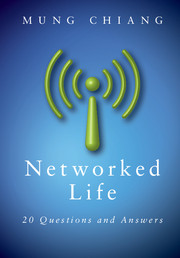Book contents
- Frontmatter
- Contents
- Preface
- Acknowledgements
- Roadmap
- 1 What makes CDMA work for my smartphone?
- 2 How does Google sell ad spaces?
- 3 How does Google rank webpages?
- 4 How does Netflix recommend movies?
- 5 When can I trust an average rating on Amazon?
- 6 Why does Wikipedia even work?
- 7 How do I viralize a YouTube video and tip a Groupon deal?
- 8 How do I influence people on Facebook and Twitter?
- 9 Can I really reach anyone in six steps?
- 10 Does the Internet have an Achilles' heel?
- 11 Why do AT&T and Verizon Wireless charge me $10 a GB?
- 12 How can I pay less for each GB?
- 13 How does traffic get through the Internet?
- 14 Why doesn't the Internet collapse under congestion?
- 15 How can Skype and Bit Torrent be free?
- 16 What's inside the cloud of iCloud?
- 17 IPTV and Netflix: How can the Internet support video?
- 18 Why is WiFi faster at home than at a hotspot?
- 19 Why am I getting only a few % of the advertised 4G speed?
- 20 Is it fair that my neighbor's iPad downloads faster?
- Index
- Notes
9 - Can I really reach anyone in six steps?
Published online by Cambridge University Press: 05 November 2012
- Frontmatter
- Contents
- Preface
- Acknowledgements
- Roadmap
- 1 What makes CDMA work for my smartphone?
- 2 How does Google sell ad spaces?
- 3 How does Google rank webpages?
- 4 How does Netflix recommend movies?
- 5 When can I trust an average rating on Amazon?
- 6 Why does Wikipedia even work?
- 7 How do I viralize a YouTube video and tip a Groupon deal?
- 8 How do I influence people on Facebook and Twitter?
- 9 Can I really reach anyone in six steps?
- 10 Does the Internet have an Achilles' heel?
- 11 Why do AT&T and Verizon Wireless charge me $10 a GB?
- 12 How can I pay less for each GB?
- 13 How does traffic get through the Internet?
- 14 Why doesn't the Internet collapse under congestion?
- 15 How can Skype and Bit Torrent be free?
- 16 What's inside the cloud of iCloud?
- 17 IPTV and Netflix: How can the Internet support video?
- 18 Why is WiFi faster at home than at a hotspot?
- 19 Why am I getting only a few % of the advertised 4G speed?
- 20 Is it fair that my neighbor's iPad downloads faster?
- Index
- Notes
Summary
In the last chapter, we saw the importance of topology to functionality. In this and the next chapters, we will focus on generative models of network topology and reverse-engineering of network functionality. These are mathematical constructions that try to explain widespread empirical observations about social and technological networks: the “small world” property and the “scale free” property. We will also highlight common misunderstandings and misuse of generative models.
A Short Answer
Since Milgram's 1967 experiment, the small world phenomenon, or the six degrees of separation, has become one of the most widely told stories in popular science books. Milgram asked 296 people living in Omaha, Nebraska to participate in the experiment. He gave each of them a passport-looking letter, and the destination was in a suburb of Boston, Massachusetts, with the recipient's name, address, and occupation (stockbroker) shown. Name and address sound obvious, and it turned out that it was very helpful to know the occupation. The goal was to send this letter to one of your friends, defined as someone you knew by first name. If you did not know the recipient by first name, you had to send the letter via others, starting with sending it to a friend (one hop), who then sent it to one of her friends (another hop), until the letter finally arrived at someone who knew the recipient by first name and sent it to the recipient. This is illustrated in Figure 9.1.
- Type
- Chapter
- Information
- Networked Life20 Questions and Answers, pp. 194 - 213Publisher: Cambridge University PressPrint publication year: 2012



